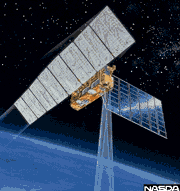JERS
Japanese Earth Resources Satellite
 JERS-1 is Japan's 2nd Earth observation satellite. It is designed to provide global, all-weather imaging capability for agriculture, forestry, fishery, environmental protection, and disaster protection use. Some data will be also shared with the University of Alaska for research uses.
JERS-1 is Japan's 2nd Earth observation satellite. It is designed to provide global, all-weather imaging capability for agriculture, forestry, fishery, environmental protection, and disaster protection use. Some data will be also shared with the University of Alaska for research uses.
Spacecraft
3-axis stabilized, zero momentum bias system with magnetotorquers, reaction wheels. Earth, sun sensors provide 0.3 deg attitude knowledge. Hydrazine propulsion system. 72 Gbit solid state recorder. Single solar panel is 3.4 m x 8 m and provides 2050W BOL. 4 30 Ahr NiCd batteries.
Payload
SAR (Synthetic Aperture Radar) is L-band using HH polarization with a 35 deg look angle. The SAR has 18 m resolution (3 looks) with a 75 km swath and uses a corporate feed antenna 11.9 m x 2.4 m. Optical Sensor (OPS) can observe in 7 bands from visible to short wave infrared with stereoscopic
imaging by a forward look of 15.3 deg, and provides 18 m resolution.
| Country of Origin | Japan |
| Customer/User | NASDA |
| Manufacturer(s) | Mitsubishi Electric Co. (MELCO) |
| Size | 1 x 1.8 x 3.1 m (bus) with 2.5 x 12 m SAR antenna |
| Orbit | 568 km circular, sun-synchronous, 98 deg inclination, with 44 day repeat period and 10:45 am descending node |
| Related Sites | NASDA JERS Page |
Launch Facts
| Name | Int'l Desig. | Date | Site | Vehicle | Orbit | Mass(kg) |
| Notes | ||||||
| JERS-1 | 1992-007A | 2/11/92 | Tanegashima | H-1 | LEO | 1340 |
| Japanese Research Satellite-1 | ||||||
Information in The Mission and Spacecraft Library is provided without warranty or guarantee. USE AT YOUR OWN RISK.